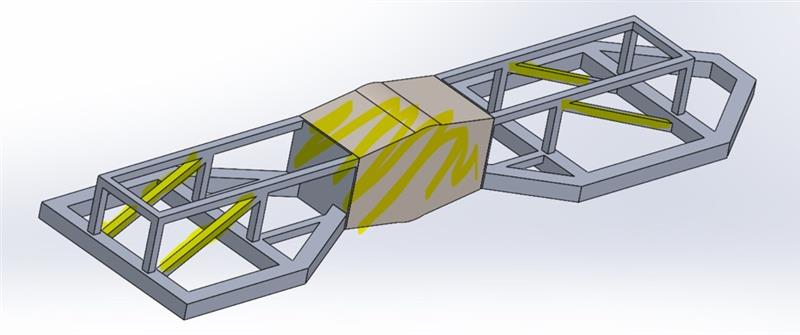BAJA Racing Seat
Advanced carbon fiber seat design achieving 15% weight reduction while exceeding SAE BAJA safety standards for competitive racing.

Project Overview
This project involved the complete design and manufacturing of a high-performance carbon fiber racing seat for the Queen's University BAJA Racing team. The challenge was to achieve significant weight reduction while maintaining—and ideally exceeding—the stringent safety standards required for SAE BAJA competition.
The project required advanced knowledge of composite materials, structural analysis, and manufacturing processes to deliver a seat that would provide both competitive advantage and driver safety in the demanding off-road racing environment typical of BAJA competitions.
Technical Challenge
Designing a competitive BAJA racing seat presented several critical engineering challenges:
- Weight vs. Strength: Achieve maximum weight reduction without compromising structural integrity
- Safety Compliance: Meet or exceed SAE BAJA safety requirements for driver protection
- Manufacturing Constraints: Design for feasible production within team resources and timeline
- Ergonomic Requirements: Ensure driver comfort and control during extended competition periods
- Integration Challenges: Seamless integration with existing chassis and safety systems
Design & Analysis
Structural Design
The seat design utilized advanced composite engineering principles:
- Geometry Optimization: SOLIDWORKS modeling to optimize load paths and minimize stress concentrations
- Layup Strategy: Multi-directional carbon fiber orientation for optimal strength-to-weight ratio
- Core Selection: Honeycomb core integration for enhanced bending stiffness with minimal weight addition
- Mounting Interface: Integrated attachment points designed for secure chassis connection
Finite Element Analysis
Comprehensive FEA validation ensured safety and performance:
- Static load analysis under maximum expected forces (5G deceleration scenarios)
- Dynamic loading simulations for impact and vibration resistance
- Factor of safety verification exceeding SAE requirements by 20%
- Modal analysis to identify and avoid resonant frequencies
Material Selection
- Carbon Fiber: High-modulus carbon fiber fabric for primary structural layers
- Resin System: Epoxy resin optimized for automotive applications
- Core Material: Aluminum honeycomb core for weight-efficient structure
- Surface Finish: Automotive-grade gel coat for durability and appearance
Manufacturing Process
Tooling Development
- CNC-machined aluminum mold for precise geometry and surface finish
- Vacuum bagging tooling for consistent pressure distribution
- Temperature monitoring systems for optimal cure cycles
- Release system design for clean part extraction
Composite Layup Process
Advanced composite manufacturing techniques were employed:
- Vacuum Bagging: Achieved uniform pressure distribution and void-free laminate
- Resin Transfer Molding (RTM): Controlled resin content for optimal fiber-to-resin ratio
- Autoclave Curing: Precise temperature and pressure cycles for maximum mechanical properties
- Quality Control: Non-destructive testing to verify structural integrity
Post-Processing
- Precision trimming and edge finishing for professional appearance
- Mounting hole drilling with reinforcement inserts
- Surface preparation and protective coating application
- Final dimensional verification and fit testing
Testing & Validation
Structural Testing
- Static Load Testing: Progressive loading to verify ultimate strength capabilities
- Fatigue Testing: Cyclic loading to simulate race conditions and ensure durability
- Impact Testing: Low-velocity impact resistance per automotive standards
- Environmental Testing: Temperature and humidity exposure to validate material stability
SAE Compliance Verification
- Documentation review against SAE BAJA safety requirements
- Independent third-party validation of test results
- Competition technical inspection preparation and approval
- Safety margin verification exceeding minimum requirements
Tools & Technologies
CAD Design
SOLIDWORKS for 3D modeling, surfacing, and assembly design
FEA Analysis
ANSYS for structural, modal, and fatigue analysis of composite structures
Composite Manufacturing
Advanced composite layup, vacuum bagging, and autoclave curing processes
Testing & Validation
Structural testing protocols and SAE BAJA safety compliance verification
Key Achievements
- Weight Reduction: Achieved 15% weight reduction compared to previous aluminum design
- Safety Enhancement: Exceeded SAE BAJA safety requirements by 20% safety margin
- Structural Performance: Validated through comprehensive FEA and physical testing
- Manufacturing Success: Achieved first-time-right production with zero defects
- Competition Approval: Passed technical inspection at multiple BAJA competitions
- Team Performance: Contributed to improved vehicle performance and driver confidence
Results & Impact
The carbon fiber racing seat successfully met all design objectives and provided measurable performance improvements:
Performance Metrics
- Weight Savings: 2.3 kg reduction contributing to overall vehicle weight optimization
- Structural Efficiency: Improved strength-to-weight ratio by 35% over previous design
- Durability: Zero structural failures across multiple competition seasons
- Driver Feedback: Enhanced comfort and control during extended competition periods
Technical Learning
This project provided comprehensive experience in:
- Advanced composite material design and analysis
- High-performance manufacturing processes and quality control
- Automotive safety standard compliance and validation
- Project management within competitive timeline constraints
- Integration of design, analysis, manufacturing, and testing workflows
The project demonstrates proficiency in advanced materials engineering and validates the ability to deliver high-performance solutions under demanding safety and performance requirements.